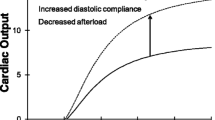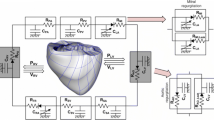Abstract
We proposed a mathematical model to describe the early filling process of the left ventricle and applied the model toin vivo experiments. The solution of a second-order differential equation indicated that the pressure difference between the left atrium and ventricle during ventricular filling (PD) could be explained by a transient response, i.e. decremental oscillation, in an LCR circuit. Thereafter, we analysed the sequence of PD during vagal stimulation with two catheter-tip manometers in 12 anaesthetised dogs and evaluated changes in the parameters of the system under various haemodynamic conditions. The values of ωn and ξ were quite stable among beats within an episode of vagal stimulation, between episodes and even among dogs, despite the changes in haemodynamic variables. Pericardiotomy and partial discommunication of the mitral valve with the left ventricular free wall by cutting the mitral chordal tendons decreased ωn and increased ζ, mainly because of the increase in CLV. Occlusion of the coronary vascular beds with large numbers of microspheres increased ωn and decreased ζ, mainly because of the decrease in CLV. Mitral obstruction with an inflated balloon (increase in R) abolished the oscillatory changes and produced and exponential decay sequence of PD. In conclusion, both the logical and experimental approaches indicated that the sequence of PD could be considered as decremental oscillation in the LCR circuit and the parameters ωn and ξ could be good indices of the diastolic property of the left ventricle
Similar content being viewed by others
References
Cheng, C. P., Freeman, G. L., Santamore, W. P., Constantinescu, M. S., andLittle, W. C. (1990): ‘Effects of loading conditions, contractile state, and heart rate on early diastolic left ventricular filling in conscious dogs,’Circ. Res.,66, pp. 814–823
Courtois, M., Kovacs, S. J., andLudbrook, P. A. (1988): ‘Transmitral pressure-flow velocity relation: Importance of regional pressure gradients in the left ventricle during diastole’,Circ.,78, pp. 661–671.
Gilbert, J. C., andGlantz, S. A. (1989): ‘Determinants of left ventricular filling and of the diastolic pressure-volume relation,’Circ. Res.,64, pp. 827–851
Glantz, S. A. (1979): ‘Response of a fluid-filled catheter to step and sinusoidal pressure changes,’in Glantz, S. A. (Ed.): ‘Mathematics for biomedical applications’ (University of California Press, Berkeley) pp. 116–127
Hori, M., Inoue, M., Kitakaze, M., Koretsune, Y., Iwai, K., Tamai, J., Ito, H., Kitabatake, A., Sato, T. and Kamada, T. (1986): ‘Role of adenosine in hyperemic response of coronary blood flow in microembolization,’Amer. J. Physiol.,250, pp. H509-H518
Inagaki, H., Mizuno, M., Igarashi, I., Kitano, T., Okino, H., Kitamura, K., Nakata, Y., Takahashi, F., Sato, H., Suzuki, S., Kimata, S., and Tamura, N. (1983): ‘Catheter-tip transducer,’Biomed. Eng.,21, p. A-47
Ishida, Y., Meisner, J. S., Tsujioka, K., Gallo, J. I., Yoran, C., Frater, R. W. M., andYellin, E. L. (1986): ‘Left ventricular filling dynamics: Influence of left ventricular relaxation and left atrial pressure,’Circ.,74, pp. 187–196
Kovasc, S. J. Jr., Barzilai, B., andPerez, J. E. (1987): ‘Evaluation of diastolic function with doppler echocardiography: the PDF formalism,’Amer. J. Physiol.,252, pp. H178-H187
Ling, D., Rankin, J. S., Edwards, C. H., McHale, P. A. andAnderson, R. W. (1979): ‘Regional diastolic mechanics of the left ventricle in the conscious dog,’Amer. J. Physiol.,236, pp. H323–330
Nobel, M. I. M. (1968): ‘The contribution of blood momentum to left ventricular ejection in the dog,’Circ. Res.,23, pp. 663–670
Okino, H., andSpencer, M. P. (1962): ‘Relationship between blood ejection and pressure gradient across the pulmonary valve,’Federation Proc.,21, p. 135 (abstract)
Slinker, B. K., andGlantz, S. A. (1985): ‘The accuracy of inferring left ventricular volume from dimension depends on the frequency of information needed to answer a given question,’Circ. Res.,56, pp. 161–174
Spencer, M. P., andGreis, F. C. (1962): ‘Dynamics of ventricular ejection,’Circ. Res.,10, 274–279
Yellin, E. L., Laniado, S., Peskin, C. S., andFrater, R. W. M. (1976): ‘Analysis an interpretation of the normal mitral valve flow curve’in Kalmanson, D. (Ed.): ‘The mitral valve’, (Edward Arnold, London) pp. 163–183
Author information
Authors and Affiliations
Rights and permissions
About this article
Cite this article
Haruyama, S., Mori, H., Wan, L.M. et al. Electrical analogy of diastolic pressure difference between left atrium and ventricle. Med. Biol. Eng. Comput. 32 (Suppl 1), S91–S98 (1994). https://doi.org/10.1007/BF02523334
Received:
Accepted:
Issue Date:
DOI: https://doi.org/10.1007/BF02523334




